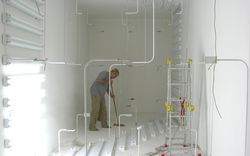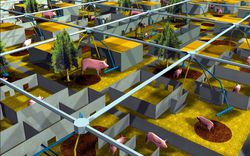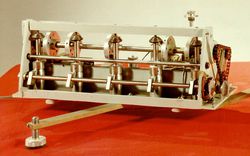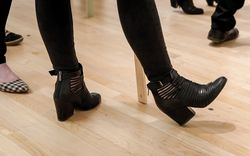The second advertisement is by a private company that no longer exists and that was based in Pittsburgh. The goal was to promote “Nepcoduct”, a system of raceways for electric and telephone cables conceived for use in new office buildings. A giant hand, a baleful embodiment of corporate power, moves a clerk on an office plan like a pawn in a chess game. The slogan emphasizes the flexibility allowed by Nepcoduct in organizing the layout of office space: “Move John anywhere”.
In a surprising flash-forward we can imagine again meeting Johnny, now a young adult who recently entered the job market as a white-collar employee. He left the suburban surroundings of his panel-heated primary school and now works in an office building in the dense city centre. Technological systems are always there with all their amazing power, though now John seems not a beneficiary of progress but a victim of it. The explanatory text mentions the owners of the building where John works, as well as the tenants, the architects and the builders. They are all supposed to be interested in the virtues of cheapness and flexibility offered by Nepcoduct. On the other hand, the mass employee John loses any residual autonomy in front of his corporate employer thanks to the performance of the cables embedded in the floating floor.
The performance of buildings post-WWII became an important issue in the architectural debate, particularly in North America. Buildings were criticized not only on the basis of “intrinsically architectural” features such as how forms and functions interact within a building and how the building interacts with its surroundings. Buildings started to also be judged as machines that produced an interior environment where air and light were controlled. This expectation was stronger in the case of non-residential buildings, since comfortable working conditions were considered crucial to efficient production, either in factories, offices or selling spaces.
On the other hand, the same expectation was present in the residential sector. “The American Style has hidden Performance” was stated in October 1950 in the popular monthly House Beautiful, dedicated to the interior decor of homes. This journal was rather unengaged in the struggle to disseminate architectural forms that could be considered properly “Modern”, although it advocated a new style that identified with the triumphant postwar United States. In House Beautiful’s vision, “American Style” had to be based on the performance of technological systems embedded in homes, and thus on the comfort of the dwellers.
The 1940s and 1950s in America were a time of great expectation from architecture and particularly from the advancement of building elements and technical systems. Environmental concerns were yet to come and industrialization was not shadowed by fears of overproduction. “The producers in America . . . are in a unique position to influence contemporary architecture” proclaimed the January 1948 editorial in The Architectural Review.
The contribution from other industrial sectors was made possible by diffuse confidence in technological progress. The meeting of architecture and industry dreamed of by the European avant-garde of the 1920s and 1930s eventually happened, although not through social engineering or revolution as they wished, but through the market.











